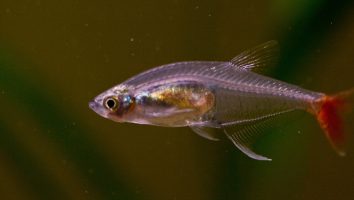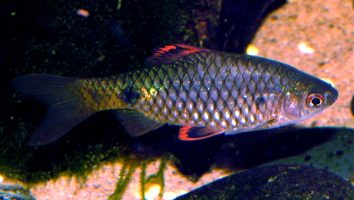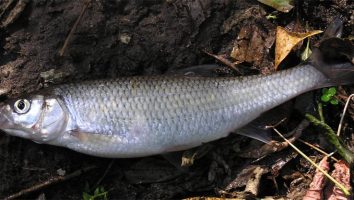Bala Sharks are a semi-aggressive freshwater fish that is often kept in community tanks.
Despite their peaceful appearance, these sharks can grow quite large and should only be kept with fish that can defend themselves.
This guide will teach you everything you need to know about Bala Shark care. From tank size and diet to tank mates and lifespan, we’ve got you covered.
Table of contents
Species overview
The Bala Shark (scientific name: Balantiocheilos melanopterus) is a freshwater fish that is native to Southeast Asia. It is most commonly found in Thailand, Cambodia, Laos, Vietnam, and Malaysia.
The Bala shark is a very popular fish for aquariums because of its unique shape and beautiful color. It is silver with black stripes running along its body.
The Bala shark is a very peaceful fish and is generally compatible with other fish that are the same size or larger. However, it is important to note that the Bala shark is a very active swimmer and needs a lot of space to swim.
The Bala shark is also a very good jumper, so it is important to have a lid on your aquarium.
Appearance

The first thing you’ll notice about the Bala shark is their long and torpedo-shaped body. These fish are very streamlined which helps them zip through the water at high speeds.
They have a dorsal fin that runs the length of their body and a small anal fin. The dorsal fin is triangular in shape and has a slight forward curve. The anal fin is also triangle-shaped but it curves back towards the tail.
Both of these fins are supported by long and thin rays. The caudal fin is forked and quite tall.
The body of the Bala shark is covered in small scales that have a silver sheen to them. There is a black stripe that runs along the length of their body from the tip of their nose to the base of their tail.
This stripe is bordered by a thin line of gold. The rest of their fins are translucent with a slight yellow tint.
The Bala shark is a very popular fish for freshwater aquariums. They’re easy to care for and make a beautiful addition to any tank.
Lifespan
Bala sharks are a long-lived species with a lifespan of 10 to 12 years in captivity. In the wild, their lifespan is likely shorter due to predation and other risks.
Bala sharks are a schooling species, so they do best when kept in groups. They are also an active swimmer and need a tank that is at least 125 gallons in size.
Size
The average Bala Shark size is between 12 and 14 inches long, but they can grow up to 20 inches in length in the wild. These freshwater fish are some of the largest that can be kept in a home aquarium, so make sure you have enough space to accommodate them.
Tank
Tank Size
The minimum tank size for a bala shark is 125 gallons. If you want to keep more than one fish, you’ll need an additional 50 gallons for each fish.
These fish are very active swimmers and will need the extra space to move around. They’re also known to be jumpers so you’ll need to make sure your tank is covered.
Water Parameters
Bala sharks are a freshwater fish that come from tropical rivers in Southeast Asia. As such, they require warm water with a neutral to slightly acidic pH.
The water temperature should be between 75 and 82 degrees Fahrenheit, with a pH between 6.8 and 7.2. Water hardness is not as critical, but aim for something in the moderate to hard range.
Bala sharks are a schooling fish, so they need a lot of space. A 55-gallon aquarium is the bare minimum for a single fish. If you plan to keep more than one, you’ll need an even larger tank.
- Water Temperature: 75 to 82 degrees Fahrenheit
- pH Levels: 6.8 to 7.2
- Water Hardness: Moderate to hard
- Alkalinity Levels: Not as critical
What To Put In Their Tank
When it comes to setting up the inside of an aquarium for Bala Sharks there are a few different routes you can take.
The most popular option is to go with a plants and driftwood theme. This gives the tank a bit of cover for your fish and some places to hide. It also provides a place for algae to grow which these fish love to eat.
You can use just about any type of plant in their tank. We prefer to use fast-growing plants that can handle a little bit of abuse (since these fish love to swim through them).
Something like Hornwort or Water Wisteria is a great choice.
As for driftwood, make sure it’s completely submerged. Bala Sharks love to chew on wood, so any that’s exposed will likely get nibbled on.
You can also go with a more traditional setup and use rocks and caves instead of plants and driftwood. This is a perfectly fine option, but keep in mind that these fish love to swim in open spaces.
Don’t go overboard with the decorations and leave plenty of room for them to swim!
The substrate in their tank can be anything you want. Gravel is always a good choice, but sand is perfectly fine too.
Common Diseases
There are a couple of diseases that you’ll want to look out for with your bala sharks. They aren’t prone to sickness like some other species of fish, but they aren’t immune to subpar living conditions either.
The first one that you’ll want to keep an eye out for is hole-in-the-head disease. This is a rather gruesome looking illness that stems from poor water quality and the presence of activated carbon in your tank.
This will present itself as one or two pits/holes in the skin of your bala shark’s head. While it’s almost always curable (fixing your water quality and removing activated carbon is usually all you need to do), it will usually leave some scarring on your poor fish!
The other disease you’ll want to keep an eye out for is ich. This is obviously not a bala shark-specific illness, but since ich is so common it’s definitely worth mentioning here.
This will show itself as white spots on the body, fish, and gills of your fish. We won’t do a full ich treatment guide here (there are plenty of those online) but it’s something you need to take very seriously if it affects your bala shark.
Behavior & Temperament
Bala sharks are one of the most active freshwater fish in the aquarium trade. They’re constantly on the move, swimming from one end of the tank to the other. They love to explore and are always curious about their surroundings.
Bala sharks are also social creatures. They prefer to live in groups and will often school together. If you’re only keeping one Bala shark, it’s best to provide it with plenty of places to hide. Otherwise, it may become stressed and its health will suffer.
Bala sharks are peaceful fish, but they can be a bit nippy. They may nibble on the fins of their tank mates, so it’s best to keep them with fish that are too large to fit in their mouths.
Tank Mates
Bala sharks are one of the few species on this list that are best kept alone. In the wild, they live in schools of their own kind.
The problem is that most aquariums are too small to support a school ofbalas. And, when kept alone, they’re known to be rather nippy.
For these reasons, it’s generally best to avoid keeping bala sharks with other fish. If you must, try to find a tank mate that’s large enough to not be considered food and is also semi-aggressive.
Some possible tank mates include:
- Oscar Fish
- Green Terror Cichlid
- Firemouth Cichlid
- Jack Dempsey
- Convict Cichlid
- Plecostomus (common pleco)
Breeding
Bala sharks are a bit difficult to breed in captivity. They’re very particular about their environment and need specific conditions to spawn.
The first step is to set up a breeding tank. It should be at least 100 gallons and have a sandy bottom. You should also add some plants and driftwood for decoration.
Then, you need to adjust the water temperature. Bala sharks like it a bit on the warm side. Aim for 86 degrees Fahrenheit.
The next step is to add the right ratio of males to females. You should have two males for every female.
Once the tank is set up and the fish have acclimated, you can start feeding them live foods. This will help to encourage spawning.
When the fish are ready to spawn, you’ll see the males chasing the females around. The female will then lay her eggs in the plants.
The eggs are sticky and will attach to the leaves. After she lays them, the male will fertilize them.
You must remove the adults from the tank at this point. They will eat the eggs if given the chance.
The eggs will hatch in about two days. When they do, you can start feeding the fry live foods. Baby brine shrimp is a good option.
As they grow, you can slowly introduce them to flake food.
Conclusion
Bala Sharks are a semi-aggressive freshwater fish that can grow up to 24 inches long.
They’re a popular choice for many aquariums because of their unique look and relatively easy care.
However, there are a few things you need to know before you decide to add one to your tank.
In this guide, we’ll give you all the information you need to know about Bala Sharks so you can decide if they’re the right fish for you.












